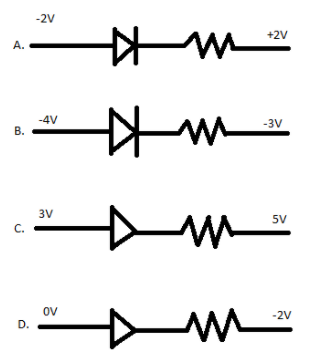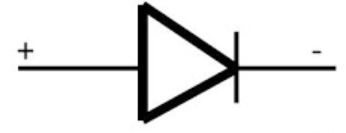
The forward biased diode

Answer
141.9k+ views
Hint: Here, we get the answer by knowing about the PN Junction diode and its characteristics of forward bias current flows from higher potential to lower potential and from opinion you can get the answer.
Complete step by step solution:
The P-N junction diode can be represented by

in which the ‘+’ side is called a cathode. In the forward bias current flows from anode to cathode and anode must be connected to higher potential and cathode must be connected to lower potential. When voltage is supplied from the battery source current starts to flow from higher potential to lower potential and is the same way diodes must be inserted that current enter from anode side and leave from cathode side. Anode side is also called P side and cathode side also called N side. Therefore the voltage must be higher at the anode side and voltage must be lower at the cathode side. So, from options we can see in option(D) only, the P side is at higher potential than n side.
P side (anode) at ’0’ volt and n side (cathode) at ‘-2’ volt.
Note: In the case of reverse bias, the polarity of battery change and there current enters to n side (cathode) and leaves from p side (anode). We can see option(C) n side at higher potential (5V) and p side at lower potential (3V). So, it is the case of reverse bias diode circuits.
Complete step by step solution:
The P-N junction diode can be represented by

in which the ‘+’ side is called a cathode. In the forward bias current flows from anode to cathode and anode must be connected to higher potential and cathode must be connected to lower potential. When voltage is supplied from the battery source current starts to flow from higher potential to lower potential and is the same way diodes must be inserted that current enter from anode side and leave from cathode side. Anode side is also called P side and cathode side also called N side. Therefore the voltage must be higher at the anode side and voltage must be lower at the cathode side. So, from options we can see in option(D) only, the P side is at higher potential than n side.
P side (anode) at ’0’ volt and n side (cathode) at ‘-2’ volt.
Note: In the case of reverse bias, the polarity of battery change and there current enters to n side (cathode) and leaves from p side (anode). We can see option(C) n side at higher potential (5V) and p side at lower potential (3V). So, it is the case of reverse bias diode circuits.
Recently Updated Pages
Young's Double Slit Experiment Step by Step Derivation

Difference Between Circuit Switching and Packet Switching

Difference Between Mass and Weight

JEE Main Participating Colleges 2024 - A Complete List of Top Colleges

JEE Main Maths Paper Pattern 2025 – Marking, Sections & Tips

Sign up for JEE Main 2025 Live Classes - Vedantu

Trending doubts
JEE Main 2025 Session 2: Application Form (Out), Exam Dates (Released), Eligibility, & More

JEE Main Exam Marking Scheme: Detailed Breakdown of Marks and Negative Marking

JEE Main 2025: Derivation of Equation of Trajectory in Physics

Electric Field Due to Uniformly Charged Ring for JEE Main 2025 - Formula and Derivation

Learn About Angle Of Deviation In Prism: JEE Main Physics 2025

Electric field due to uniformly charged sphere class 12 physics JEE_Main

Other Pages
JEE Advanced Marks vs Ranks 2025: Understanding Category-wise Qualifying Marks and Previous Year Cut-offs

JEE Advanced 2025: Dates, Registration, Syllabus, Eligibility Criteria and More

JEE Advanced Weightage 2025 Chapter-Wise for Physics, Maths and Chemistry

Degree of Dissociation and Its Formula With Solved Example for JEE

JEE Main 2025: Conversion of Galvanometer Into Ammeter And Voltmeter in Physics

Dual Nature of Radiation and Matter Class 12 Notes: CBSE Physics Chapter 11




